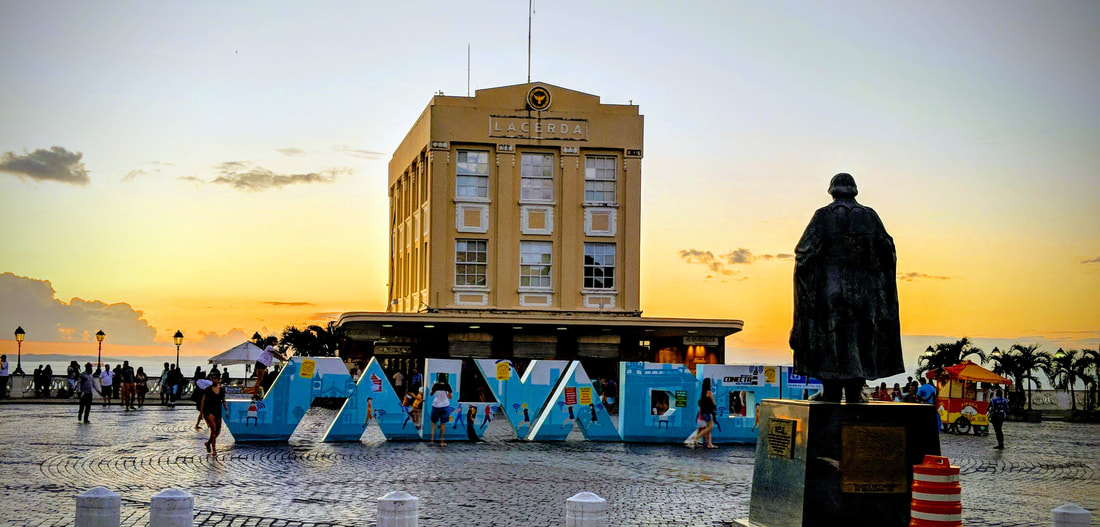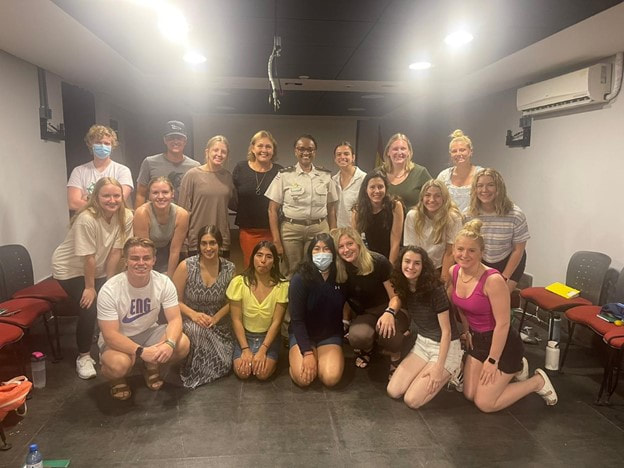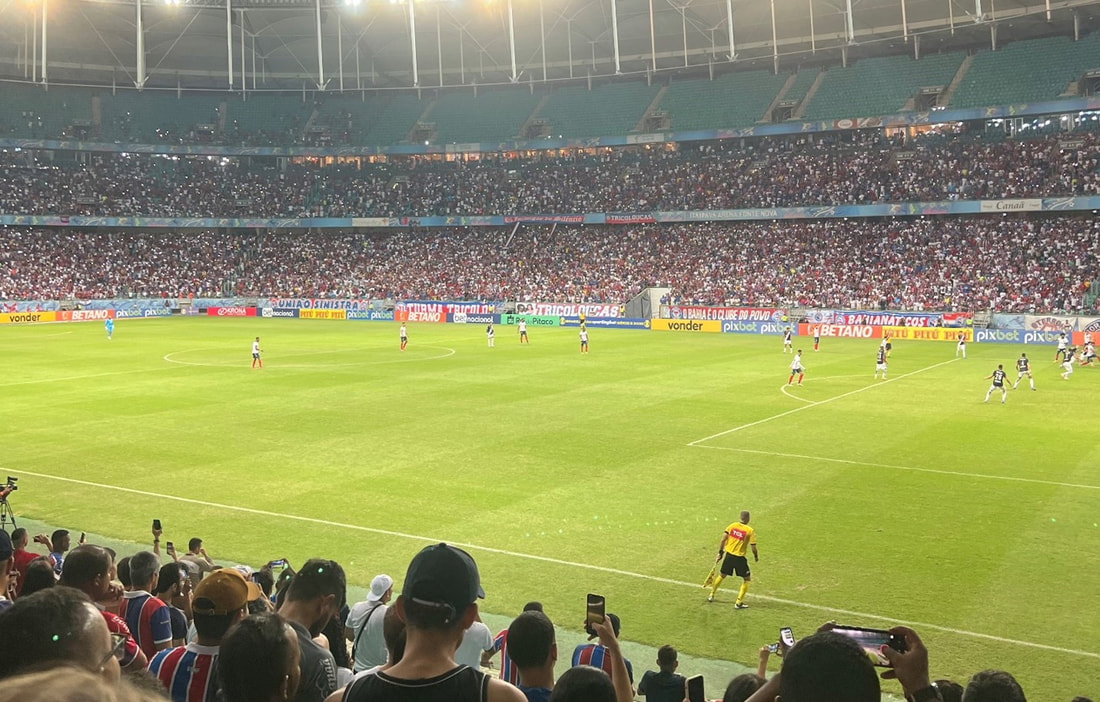|
By Tania Salgado Walking around the streets of Salvador I never felt unsafe. I felt uncomfortable at times when people would stare at me, and I couldn’t tell if they were staring because they could tell I’m American or because I’m a woman. I had an instance where a man was riding on his bike, and he had yelled something at me. I looked over and his eyes were stuck on me. I quickly looked away and looked down to see what I was wearing. It’s odd that it was my first instinct to see if what I was wearing was the reason he had yelled something at me. It is an unfortunate reality for women all over the world to think what they do, say, wear could be seen as an invitation for men to comment. Maybe the man on the bike wasn’t even talking to me or catcalling me, but he had made me super uncomfortable by the way his eyes were glued on me.
During our stay we had a lecture scheduled with Lieutenant-Colonel Denice Santiago. Unfortunately, she was unable to be there for personal reasons, so we met with Major Alcilene instead. The talk was super interesting as she explained what Ronda da Maria da Penha is. Ronda da Maria da Penha is an organization that protects women from domestic violence. It creates a bridge between security forces and civil society. She emphasized that differences aren’t a problem. It is the hierarchy of gender and race and the inequality that comes with it that is the problem. She goes on to explain that women don’t reach the top, white men do. She explains that it isn’t a problem that white men are at the top, it’s a problem that it’s always white men. This problem of a hierarchy draws back to the discussion we had in class about Afro-Brazilian feminists and White Brazilian feminists. This quote puts into perspective the hierarchy, “Although Afro-Brazilian women face daily discrimination in white and black male-dominated spaces, it is imperative to understand how racial and gendered prejudice—and even violence—have been produced by white Brazilian feminists” (Swift 2017). The idea of a hierarchy also reminds me of the talk with Clarice Mota on social disparities, racism and health inequalities in Brazil. She had mentioned that when women have miscarriages there is two ways they are handled. If you are a White woman you are treated with care and empathy. If you are a Black woman, you are not treated with the same care and are accused of self-provoking it. Major Alcilene continues to explain the different types of violence that women face. There is physical, sexual, moral, psychological, and economical. Physical violence means applying physical harm to someone and leaving physical marks like bruises, scars, or easy to see marks. Sexual violence can be a matter of martial rape. Moral violence is similar to psychological violence in the way that words are being used to harm someone. Partners make the woman feel like they are less than and call her names and tell her things that lower her self-esteem. Economical violence consists of takings someone’s money or even any assets that they have. It doesn’t necessarily have to be monetary it can also be anything that is of property to the woman like clothes and makeup. According to Major Alcilene calls about domestic abuse/violence against women is the 2nd to 3rd highest call to police in Bahia. There are 22 organization in Bahia to help domestic abuse. Major Alcilene couldn’t stress enough that violence against women is a public health issue. It should be a collective job to work against battling violence against women. This made me think about how music can have an influence in people’s behavior. In an article written by Pinho, they touch on how there was a proposal in 2012 aimed to prevent public funds to pay artists who in their work supposedly demean the image of women and encourage violence against them (2020, 11). It is great that this issue is well known and that there are measures taken to prevent more violence from happening. It is the responsibility of the state to look into any reports of domestic violence because of Lei Maria da Penha. Violence against women is a topic to be taken seriously. You are either with the victim or the oppressor and there is no in between. If you do not speak up about people who belittle women, share private explicit photos, and abuse woman then you are only contributing to the problem. Sources: Lecture on Violence against Women and Lei Maria da Penha in Brazil with Major Denice Santiago. May 24, 2024. Lecture about Social Disparities, Racism and Health Inequalities in Brazil with Professor Clarice Mota. May 24, 2024. Pinho, Osmundo. “Race and Cultural Politics in Bahia.” In Oxford Research Encyclopedia of Latin American History, 2020. Swift, Jaimee. 2017. “Afro-Brazilian Feminists and the Fight for Racial and Gender Inclusion - AAIHS.” 2017. https://www.aaihs.org/afro-brazilian-feminists-and-the-fight-for-racial-and-gender-inclusion/.
0 Comments
By Carter Potthoff As we wrap up our three weeks here in Bahia, I have begun to reflect on the experience and think about what I have learned during our stay here. There is one common theme that almost all of the activities we have done and lectures we have listened to have touched on, and that is Afro-Brazilian identity. Salvador, being the most African city outside of Africa, has a long history of Afro-Brazilian culture and resistance, which is reflected in various art forms, education, and community. It is impossible to talk about Afro-Brazilian cultures and history without talking about art, music, and dance. During my time here, I have begun to understand how different arts forms are used to tell the story of ancestors, whether enslaved people in Brazil or ancestors from Africa, and promote the Afro-Brazilian identity. We had the opportunity to learn about many of these art forms, like percussion, capoeira, Afro-Brazilian dance, and graffiti. During our percussion workshop with Mario Pam, we talked a little bit about the history of percussion in Afro-Brazilian communities and the formation of African Blocks, or blocos de carnaval, in which Afro-Brazilians came together to create music and dance during Carnaval, but they were historically targeted by police. Osmundo Pinho, a social scientist at UFBA, says that “the image of the city of Salvador as a civilized and white city appeared threatened by the African presence” (Pinho 2020, 7). The white, Brazilian elites felt threatened by something as simple as music and dance. They went as far as banning “the display of African customs with drumming”, but there was no success (Pinho 2020, 7). Afro-Brazilian drumming has a history founded on resistance, and it is still of great importance to Afro-Brazilian identity and resistance in Salvador to this day. In “AmarElo – It’s All for Yesterday”, a Netflix documentary by Brazilian rapper Emicida, he walks us through the history of Afro-Brazilians through their music. It is symbolic as well, because he tells the story during one of his concerts at the Teatro Municipal de São Paulo, which was historically a place where black Brazilians were excluded. This concert was a way for Afro-Brazilians to take back a space they were historically excluded from (Ouro Preto 2020). For me, I see Afro-Brazilian music in Salvador in a similar way; Afro-Brazilians use music to form their identity and take their claim to spaces, both physical and societal, that they have historically been excluded from. Another Afro-Brazilian custom from Bahia is capoeira, which is a kind of fusion of martial art and dance. Capoeira was documented from as far back as 17th century Brazil and has been played in Afro-Brazilian communities as a form of resistance throughout Brazilian history (Pinho 2020, 6). Capoeira, like many other forms of Afro-Brazilians arts, was once banned, but regardless, it survived and was passed down from generation to generation and it remains a practice today. Similar to other Afro-Brazilian art forms, there is connection to Afro-Brazilian religions, like Candomblé, within these practices. Both came from enslaved Africans in Brazil and are unique to Brazilian culture, and both have been used to create community building spaces for black Brazilians, like the capoeira school or the Candomblé terreiros we visited. In the book Crooked Plow, the Jarê rituals, which is a religion similar to Candomblé, were accompanied by music and dancing, and when Zeca or other characters were mounted by orixás, they danced and sang (Vieira Junior 2019). Music and dance is so central to Afro-Brazilian identity that it plays a central role in things as important as religion. At the Balé Folclórico da Bahia, we were able to see many different practices of Afro-Brazilian culture, like capoeira, Candomblé, maculelê, and samba performed in one space using dance, drumming, and singing. It was a really impactful way to end off the trip and really allowed me to make connections about everything I was seeing and learning. One last art form I want to talk about, that is much more contemporary than capoeira or drumming, is graffiti. We had the chance to visit Eder Muniz, who is a graffiti artist and tagger from Salvador. He shared with us some of his work, but also some background about graffiti and tagging and the social aspects of it as well. In a paper about “street youth” in Salvador, Marit Ursin, a sociologist at NTNU, talks about the negative connotations around street youth and how these connotations reinforce the social exclusion of these youth and continue to drive unequal structures of power (Ursin 2016). Eder talked a bit about this and said that in his case and the case of many others street artists, their art begins as a means of liberation and as a way of making themselves seen, by putting literal representations of themselves, in the form of tags, in their physical space. In a sense, tagging is about taking back their right to live and exist in their communities. Eder talked about using graffiti as a way of building community as well, and the importance of the community when making street art. He showed us some pieces around his community that he worked on, which were often accompanied by neighborhood parties or barbecues. Involving the community in the process of art is important in creating a piece that truly represents a community, but also that the community sees themselves represented in. These past three weeks in Salvador, we have had the opportunity to see and participate in all of these art forms, and I definitely have a new appreciation for art and music as a tool in resistance and building community. Sources Ouro Preto, Fred, director. 2020. Emicida AmarElo: It’s All for Yesterday. Netflix. Pinho, Osmundo. “Race and Cultural Politics in Bahia.” In Oxford Research Encyclopedia of Latin American History, 2020. Ursin, Marit. “Contradictory and Intersecting Patterns of Inclusion and Exclusion of Street Youth in Salvador, Brazil.” Social Inclusion 4, no. 4 (October 20, 2016): 39–50. Vieira Júnior, Itamar. 2019. Crooked Plow. National Geographic Books.  Carter Potthoff is a senior at Saint John's University, majoring in Hispanic Studies and Biology and minoring in Latino/Latin American Studies. He is originally from Sartell, MN. Some of his many research interests include indigenous groups, cultures, and religions in southern Mexico and Guatemala, immigration in the Americas, and racial dynamics in Latin America. In his free time, Carter loves trying out new recipes, spending time with his family and friends, and most people don't know this, but he is an avid birder! Carter is excited to visit Brazil for a second time and learn firsthand about race and gender! By Hailey Karnowski As my time here in Brazil comes to an end, I thought I would share two of the most memorable experiences that I had that deepened my understanding of Brazilian culture and led me to further question the persistent topics regarding gender. Earlier this week, our group had the pleasure of hearing from Major Denice Santiago who is a police officer in Salvador and has helped create a branch of the police force focused strictly on violence against women. Major Denice informed us about the horrors that women face in households, and how justice was rarely sought due to the fear of not being believed or not having any resources in the first place. I had figured that there was still inequality between men and women—since some of our prior research had suggested that—but was clueless to the fact that violence against women ceases to exist across many aspects of the culture. Before traveling, one of the subtopics we studied was gender’s role in Brazil. One article explained how Brazil still sees a lack of representation of women in power and it was not until 1994 that a woman was elected at the state level (dos Santos and Thomé, 2021). Knowing this, I thought it was amazing that Major Denice started in the police force at the age of 18 and holds a high ranking, but she mentioned to us that there is only so high of a position that women officers can get. Another article expressed how massive the women’s movement in Brazil was to gain the ability to vote only to be faced by backlash, and Major Denice’s talk amplified the idea that this movement has yet to see full equality (Maruci, 2018). Back to Major Denice’s important topic discussed in her lecture—the violence against women in Brazil has plagued numerous households and has not received the social and governmental attention that it needs. Thankfully, Major Denice helped start a program to solely assist in cases and incidents regarding violence against women, but an earlier experience that I had led me to believe that this violence might not just be in the household. Last week, those who wanted to were able to see a live Brazilian soccer match at the stadium in Salvador. For those unfamiliar with Brazilian soccer, soccer or “futebol” is arguably one of the most significant parts of Brazilian culture and helps unite the states and country. As an article we explored suggested, soccer is so popular because anyone can play it no matter the race or socioeconomic background and the sport has become a part of many Brazilians’ identity (Eakin, 2017). It truly brings all sorts of different people together, and as a person who loves sports, it was incredible to see this in person. The game started out like any other major league sport with fans cheering, people buying cups of beer, and guys selling snacks throughout the crowd. However, as the game became tied and the fans became frustrated, I heard numerous sexist slurs being yelled at the players, referees, and even to other fans. I was shocked at some of the things that were being said—of course I know how Americans can get with hockey and football—but it was maddening hearing that the slurs regarded women. It was not until after the game during our lecture with Major Denice that I found out that soccer games are a huge driving force with domestic violence and that the special taskforce actually stays at the stadium to ensure that no women are being harassed or hurt. It was extremely eye opening that a sport so important to a nation holds some toxic behaviors that further the inequalities that women face in society. This experience made me look at Brazil on a more intersectional level, and I realized that although things like soccer are important for unity, there still may be some people that are disadvantaged from it. Although our course explored inequalities persistent in Brazilian culture, I think it is important to note the changes that are currently being made for a more equal and equitable society for women and other marginalized groups. Since the beginning, powerful women activists have made monumental impacts on the culture that is seen today. Take Bertha Lutz and Dilma Rousseff for example. The two women fought against all odds to further women’s rights and gain political power (Noriega, 2020). Since then, women like Major Denice Santiago have been continuing this journey to fight for women’s rights, and their actions have not gone unnoticed. I can only hope that Brazil and the United States continue these efforts toward equality. Works Cited: Eakin, Marshall. “The Beautiful Game: Performing the Freyrean Vision” (2017). In Becoming Brazilians: Race and National Identity in Twentieth-Century Brazil (New Approaches to the Americas, pp. 165-199). Cambridge: Cambridge University Press. doi:10.1017/9781316800058.007 dos Santos, Pedro A. G. and Thomé, Débora, "Women and Political Power in Brazil" (2021). Political Science Faculty Publications. 70. https://digitalcommons.csbsju.edu/polsci_pubs/70 Maruci, Hannah. “Women’s struggle to vote in Brazil: same fight, different strategies” (2018). Oxford Human Rights Hub. https://ohrh.law.ox.ac.uk/womens-struggle-to-vote-in-brazil-same-fight-different-strategies/ Noriega, Christina. “Herstory: 12 Brazilian Women Who Changed the Course of History” (2020). ReMezcla. https://remezcla.com/lists/culture/herstory-brazilian-women-changed-course-history/  Hailey Karnowski is a rising senior at the College of Saint Benedict, pursuing a major in sociology and minor in political science. She is originally from Farmington, Minnesota. Hailey is the new president of the CSB rugby team and works for IT Services. She hopes to work in social work or criminology after graduating and is looking forward to gaining new experiences and perspectives while studying abroad. |
Archives
June 2024
Categories
All
|





 RSS Feed
RSS Feed
